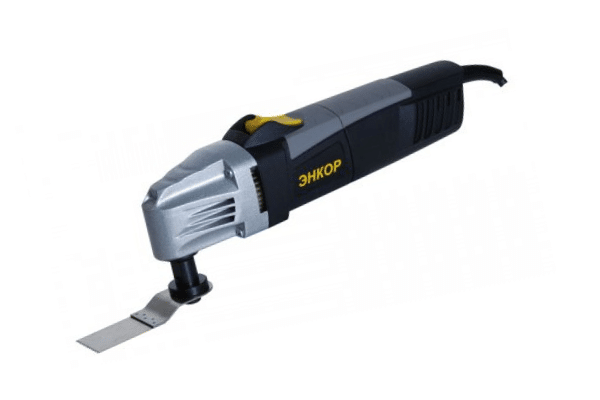
Undoubtedly the most versatile machine you’ll ever own — the amount of oscillating multi tool uses is incredible.
Whether you’re a casual DIYer, experienced home-improver, or a trade pro, these phenomenal units are an invaluable weapon in your tool armory — permitting you to chop, sand, shear, slice, hone, and polish all from one single machine.
However, many guys purchase a multitool and, through unintended ignorance, use them for just a few applications. That’s why it’s my mission to open up your oscillating world, allowing you to make the most of your mighty multitool.
Stick with me, and allow me to reveal 14 oscillating tool uses.
Why Are Oscillating Multitools So Versatile?
Obviously, the clue is in the name.
As a multitool, these machines are suited to a plethora of home and trade projects. Or perhaps more correctly, it’s their vast range of accessories that make them unmatchably flexible.
The tool itself appears somewhat innocuous. Small, compact, and relatively lightweight — without a tool head, it does little more than vibrate in your hand like a beard trimmer. However, transfer this oscillating power through to a blade, polisher, or abrasive pad — and you have a complete power tool set offered by a single machine.
Instead of filling your garage, workshop, or kitchen cupboards with a multitude of project-specific tools — such as saws, rotaries, belt sanders, and pilot drills — just get your hands on a quality oscillator.
Furthermore, not only do multitools fulfill the same functions as an immeasurable number of power units — but they can also access areas unreachable by their rather job-limited counterparts.
Time to get down to business.
14 Oscillating Tool Uses
Before we crack on, a little slice of culture.
In 1850, the respected Victorian poet Elizabeth Barrett Browning wrote,
‘How do I love thee? Let me count the ways.’
(Songs From the Portuguese, Sonnet 43).
Admittedly, in this prose, she was talking to her lover — but she could equally have been lovingly pondering her newly purchased oscillating multitool. To save you reading the poem (although if you want to it’s here), Barret Browning basically attempts to put a figure on all the reasons why she adores her beau.
Eventually, she decides it’s immeasurable and gives up — probably to have a cup of tea, create some embroidery, have a fit of the vapors, or do something equally Victorian. Read some Austen, you’ll see what I mean.
Anyway, like the Browning-meister couldn’t come up with a total number for her love — I can’t quantify the number of multi tool uses. Listed below are the 14 most common applications, but there are hundreds more.
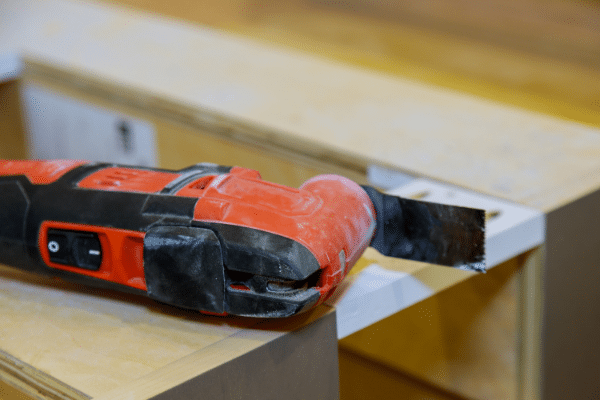
1. Undercutting Doors
Doors are wonderful things, at least when they fulfill their function of opening and shutting. Remove these aspects, and you either have a large gaping aperture or a wooden wall.
The problem is, small changes to the door’s environment and they become troublesome — swelling due to moisture, installation of a thicker room carpet, or the laying of new laminate flooring can all interfere with their operation.
Trimming the base of the door alleviates the issue, and you have two choices — remove the door or adjust in-situ. However, unhanging these large fixtures is a massive headache, typically involves more than one person, and requires a DIY horse.
Furthermore, flush cutting the base while in-situ isn’t easy with a standard circular saw — do you really want to lay on the floor with a toothed blade spinning dangerously at 7000 rpm next to your head?
The offset-angle of oscillating multitools, especially when combined with a lengthy and flat saw head — permits you to safely and effortlessly resize doors without taking them off the hinges.
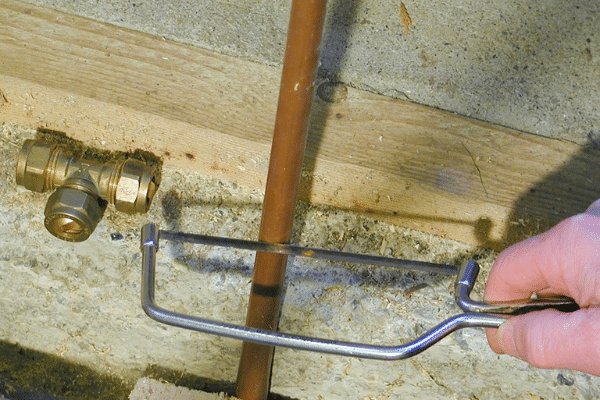
Cutting Pipes the Hard Way — Image via Eugene Brennan at pixabay
2. Trimming Pipes
Plumbers don’t tend to have many friends — mainly because they charge you a year’s salary to change a faucet washer, and smell of sewage due to spending their life with their hands down toilet U-bends.
However, if they were to have a best buddy, it would be an oscillator. As you will discover throughout this article, the uses for oscillating tool units in plumbing are vast. And perhaps their most useful function for these overpaid tradespersons is pipe cutting.
Able to slice through galvanized metal pipes as effortlessly as PVC formats, they’re ideal for bathroom and kitchen installations. Furthermore, being small and compact, they easily fit into common plumbing confined spaces such as beneath sinks and below tubs — removing the hassle of using a manual hacksaw or a cumbersome reciprocator.
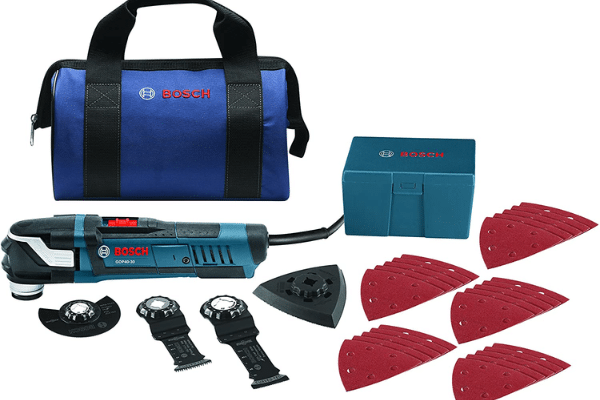
Sanding Base Plate – Ralf Pfeifer, CC BY-SA 4.0, via Wikimedia Commons
3. Flush Cutting Nails and Screws
If you’ve never used a screw that’s too long, you’re not a real DIYer or contractor.
Slight inaccuracies in measuring can mean that the screw you powered into your living room wall to hang a picture of your Aunt Mabel pokes its tiny tip out in your kitchen. Yeah, you could take down your beloved aunt’s photo frame, remove the screw, and replace it with a smaller size. That would be sensible.
Or you could whip out your mighty multitool instead.
Their flat and obtuse-angled blades permit you to cut flush to surrounding surfaces, removing any evidence of your measuring tape failures. Furthermore, they’re equally suited to leveling off bent nails and screws in old wood that are impossible to move with a claw hammer.
And, remember our beloved Barret Browning’s counting the ways? This applies here. Flush cutting isn’t reserved to screws and tacks, you can level off pipes (see? Plumbers again), gable ends, cills — anything you want.
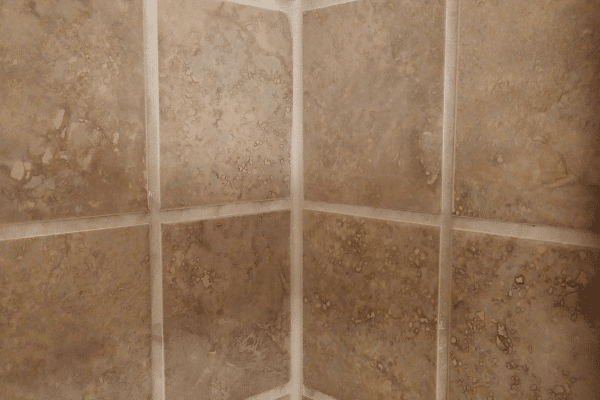
Image from Brent Hondow via pixabay
4. Removing Grout
Take a look at your bathroom grout. Go on, I’ll wait.
Back? It’s disgusting, isn’t it? Over the years, it has become discolored, worn, flaked, and cracked. What’s more, it’s now host to a plethora of microflora and fauna that have taken up residence — it’s a veritable miniature zoo.
The only solution is to remove and replace. You could manually chip it out, but I’m sure you have more useful ways to spend the next five years. Alternatively, you could use a rotary tool — but that means shooting the grouty detritus across the entirety of the room.
Instead, pick up your multitool.
The majority of manufacturers retail grout removal heads, while some machines — such as the Dremel MM50-01 — arrive with this useful attachment included with your purchase. Utilizing the oscillating action, they effortlessly remove grout without showering your bathroom with dust.
5. Creating Decking Recesses
You’ve just finished laying your outdoor decking. It looks darn amazing! You stand back and admire your completed project, dreaming of the long summer days and cool beers that you will enjoy upon this work of art.
You’re so proud, you call your wife to come out from the house to witness, appreciate, and applaud your manly achievements. She says, yeah it’s nice, but it could do with some under-step lighting, railings, and electrical sockets for ventilation fans.
Naturally, your beloved didn’t think about mentioning this before you laid all the timbers.
Thankfully, with a multitool, you don’t have to dismantle your decking — or file for divorce.
Plunge cutting blades permit you to create recesses in your underfoot timbers without having to remove the planks or drill pilot holes. Furthermore, go for a cordless oscillating multitool and you can operate your machine outside without having to think about extension cables.
And, to come back to our friends, the plumbers, they can create recesses for basins in countertops in a similar fashion.
6. Repairing Wooden Windows
If you live in an older home, wooden windows can suffer from warping, rotting, and paint flaking. Don’t give yourself the expense of purchasing replacements — instead, repair with your multitool.
The oscillator is a one-stop-shop for every aspect of window restoration — removing aged paint and varnish with a sander head, cutting recesses for weather-stripping to increase energy efficiency, eliminating rotten sections, and trimming to account for swelling.
Bear in mind, this is for timber windows — under no account try to tackle your double-glazed PVC frames.
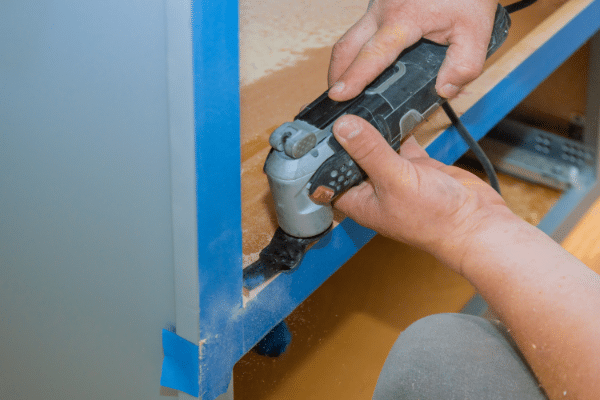
7. Fitting and Adjusting Baseboards
Similar to doors, baseboards can be troublesome if you have new carpets, floor tiling, or laminate installed. In the same way you undercut doors, you can adjust and trim baseboards while they remain in situ.
Furthermore, multitools with a segmented blade attachment are ideal for sizing and shaping new board installations without having to pull out your massive circular or miter saw from the garage. This applies equally to installing laminate (thin plank) and parquet — for more information, check out my guide on How to Use an Oscillating Tool on Wood.
8. Sanding
Whether you’re removing old and tired paint and varnish, smoothing timber to free it from splinters, or preparing for a varnish layer — multitools are the experts at sanding.
Most oscillators, including the DIY-focused Black+Decker BD200MTB, arrive with a sanding plate included. This permits you to attach a plethora of different grit and grade abrasive pads to suit the intensity of your project.
Furthermore, with their triangular shape and pointed edges, they’re excellent at penetrating troublesome tight areas such as fine molding — where stubborn paint and varnish typically take permanent residence.
That said, some projects will require you to utilize a traditional belt sander. It’s unwise to utilize an oscillating multitool on larger jobs such as stripping a door or renovating a dining table — unless you want to use up the world’s stock of sanding pads.
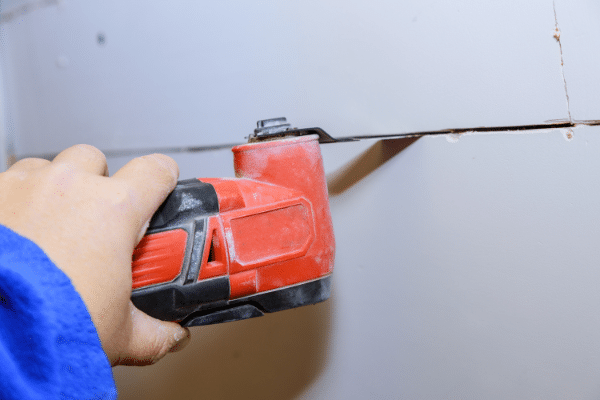
9. Creating Drywall Openings
Ask any trade builder what is an oscillating tool used for, and they’ll say cutting holes in drywall.
Watch any of the forgettable home-improvement programs on TV, and as soon as a recess needs to be created in the gypsum board, they will produce their multitool.
The sharp, precise, and compact saw heads are excellent at creating openings for sockets, light fittings, and wall switches — or for removing damaged or water-stained areas. Furthermore, you can use your oscillator to shape the drywall prior to installation.
Remember, that when attempting any cutting of your already-fitted drywall, you should check for the existence of hidden wiring or water piping.
10. Removing Excessive Caulk
Not only does it create a tight seam in bonds and joints, but it’s also a wonderful product to fill in the gaping holes caused by your completely incorrect measurements. To be honest, I think there’s currently more caulk holding my house together than mortar.
However, just because you rely on this wonderful tubed material to fix your handiwork — it doesn’t mean you want your wife, friends, family, and annoying Hank next door to know.
Utilizing a scraper blade fitted to your oscillator, you can cut off any caulk excess — tidying up the job and keeping your secret under wraps.

11. Rust Removal
You can purchase hardcore chemical rust remover, but this tends to be seriously bad for the environment. And you don’t want to kill endangered pandas or cute baby kittens do you?
A heavy grit pad attached to your multi tool’s sanding plate can remove oxidized metal without murdering innocent animals. Furthermore, the oscillating action doesn’t leave behind the circular scratch marks concomitant to orbital sanders and handheld rotary machines.
Whether you’re restoring old garden tools, fixing up your bicycle, or preparing your wrought iron gate for a repaint — your multitool can cope. Just remember to wear a mask — it’s nice saving the planet, but it’s of little value if you die of siderosis.
12. Eliminating Old Thinset
Tiles, especially those in kitchens, can inexplicably jump off the wall — meaning it either has to be remounted or replaced when it fell and smashed on your granite countertop.
The issue is, if you just stick it back on, the old and dried thinset will make it stand proud from all its surrounding tile friends. You need to eliminate the existing mortar before rehanging.
Undoubtedly the easiest method is to use your multi-tool to remove the existing adhesive. Ideally, use a carbide-tipped blade that can cope with the tough material, then the sander plate to expel smaller remnants.
You will then have a perfectly smooth surface on which to apply your tile and new thinset coat.
13. Stripping Aged Adhesives
Adhesives are great, theoretically. They’re really sticky (duh), meaning they’re ideal for securing carpets and laminate boards. However, the problem is they have such a strong bond that they’re a nightmare to remove when no longer needed.
Not only do glues and mastics adhere like, well, glue — they also become harder than diamonds (ok not literally, but almost). This means they require significant physical effort with a handheld scraper to tackle — for example, when you’re planning on laying new floors.
So, you’ve guessed it, whip out your multitool, fit a steel scraping head, and watch with pleasure as the annoying cement becomes unstuck.
14. 101 Other Uses (well, 10)
If the above list of applications isn’t sufficient and you want more, you can also utilize your multi tool to:
- Fit door jambs.
- Recess door hinges.
- Make picture frames.
- Remove metal burrs.
- Eliminating model-kit sprues.
- Pulling up carpets.
- Shaping acrylic sheet.
- Making miter joints.
- Fitting ceiling pendants.
- Shortening table legs.
Additionally, use your imagination — the capabilities of an oscillating multi-tool are endless. Furthermore, here are some pro-level oscillating tool tips and tricks for the ultimate results:

How to Use an Oscillating Multi Tool Conclusion
With an endless list of applications, it can take the place of the majority of project-specific tools in your garage or workshop. Boasting an almost inexhaustible supply of different blade and accessory heads — it’s the complete all-rounder.
I hope you enjoyed this article, and now understand why I felt it important to reveal the flexibility of this crucial tool. If you have a buddy who you believe would benefit from reading my Oscillating Multi Tool Uses Guide, please feel free to share!
What Is a Multi Tool Used For FAQs?
Q: What Is an Oscillating Tool?
A multitool is an electrically powered unit — either corded or cordless — that has an oscillating head. Through various attachments, you can use these machines to sand, cut, trim, shape, and hone.
Q: How to Use a Multi Tool to Cut Wood?
Oscillating multitools are excellent machines for sizing doors, shaping baseboards, and adjusting timber moldings — ideally when utilized with a segmented (or seg) cutting blade. For tips to deliver the ultimate results, check out my Multi Tool Wood Cutting 101.
Q: Is Using a Multi Tool Difficult?
No! With few switches or buttons and straightforward operation, even the most novice DIYer can adequately wield an oscillating multitool. For the best results, always ensure you’re using the correct attachment for the project in hand — take a look at my guide to blades and accessories here.
Q: How to Use Oscillating Tool On Metal?
Oscillating multitools are excellent for metal projects — including rust removal, cutting galvanized pipes, and preparing wrought iron gates for repainting. To discover the correct method for addressing metal materials with a multitool, take a look at my 101 on using a multi tool on steel, iron, and aluminum here.
Q: How to Use An Oscillating Saw Blade on Timber?
When cutting, trimming, and shaping wood, utilize a segmented blade with your multitool. For a complete guide to addressing timber with this versatile tool, check out my guide.










